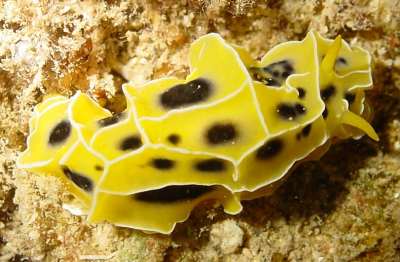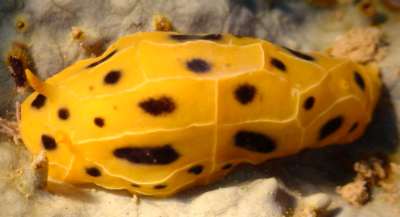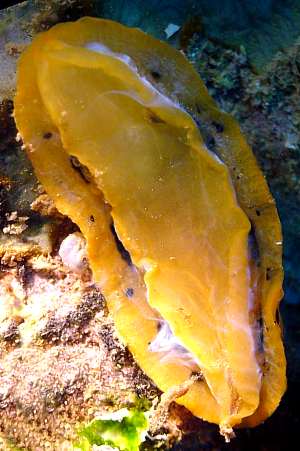Reticulidia suzanneae from Mayotte
December 6, 2003
From: Marina Poddubetskaia


Dear Bill,
During my collecting mission in Mayotte I saw 2 Reticulidia suzanneae. Each time I touched them to turn them over (for the ventral view photo), they secreted a milky white substance. It can be clearly seen in the ventral view photo [lower photo]. What is it ? I assume it is a toxic secretion and a defensive reaction. What do phyllidiids secrete exactly, toxins or acids? In Phyllidiids the defensive reaction refers to 'allomones', but I don't know what that means. Thank you in advance for filling this gap in my knowledge.
NB. The animal in the middle photo wasn't found on this grey sponge but moved here for photo from an inaccessible place.
Upper Photo: Kongou, Mayotte Island, Indian Ocean, November 15, 2003. Site: Recif de Peitro., Depth: 11m., Size: 40mm. Lower Photos: Handrema, Mayotte Island, Indian Ocean. November 07, 2003. Site: Prevoyante., Depth: 14m., Size: 35mm
Cheers,
Marina.
nembro@nembro.info
Poddubetskaia, M., 2003 (Dec 6) Reticulidia suzanneae from Mayotte. [Message in] Sea Slug Forum. Australian Museum, Sydney. Available from http://www.seaslugforum.net/find/11616
Dear Marina,
Thanks for these photos. I am glad you mentioned you had moved the animal in the middle photo onto that sponge as I was going to include a close-up of the sponge as a possible food. Where possible, it is best if you are re-positioning animals to try and put them somewhere 'neutral' like on a piece of rock. Apart from the problem of adding misleading information, many animals react badly to being put on a sponge or cnidarian colony they are not familiar with and so are difficult to photograph. They may in fact be being stung or affected by defensive secretions being produced by the 'photogenic' colony you have selected.
Concerning defensive secretions in phyllidiids. Most genera produce rather nasty chemicals called sesquiterpene isocyanides. There can be toxic and acidic. I walked into a closed lab one morning where overnight a number of
Concerning what is an allomone. You will have heard of a hormone which is the name we give to chemical substance which an animal uses internally to communicate or send signals to other parts of its body. A whole set of words of been derived from 'hormone' to label other chemical signals.
• pheromone - a chemical substance produced by a species to communicate externally with other members of the same species. [affecting the behaviour or physiology of the same species]
• allomone a chemical substance produced by a species to communicate externally with members of different species. [affecting the behaviour or physiology of another species]
Unfortunately some people feel the need to try and define and name every alternative phenomenon and I am afraid they are at present attempting to narrow the definition of allomone. When it was first proposed its meaning was as I have stated above “a chemical substance released by one species that serves as a communicative
signal to another species”. You should be aware that some people have a much narrower definition:
• allomone Compound produced by one organism that affects, detrimentally, the behaviour of a member of another species.
• kairomone Compound produced by one organism that affects, beneficially, the behaviour of a member of another species, but hurts the animal that produces it.
• synomone Compound produced by one organism that is beneficial to both itself and a member of another species.
Personally I find life becomes unnecessarily complicated when some of out colleagues feel the need to pigeon-hole natural phenomena so minutely.
Best wishes
Bill Rudman
Related messages
-
Reticulidia suzanneae from Sodwana Bay, S. Africa
From: Colin Ogden, October 2, 2009 -
Re : Reticulidia suzanneae from Mayotte
From: Marina Poddubetskaia, December 9, 2003 -
Reticulidia suzanneae from Comoros
From: Valeria Safonova, June 27, 2002 -
Reticulidia suzanneae from East Africa
From: Bernard Picton , May 24, 2002 -
Reticulidia suzanneae from Thailand
From: David Behrens, May 24, 2002 -
Reticulidia sp? from Thailand
From: Erwin Koehler, February 2, 2001 -
Reticulidia not Halgerda
From: Narongpon Sittithaweepat , April 11, 2000 -
Halgerda sp. from Thailand
From: Narongpon Sittithaweepat, April 10, 2000
